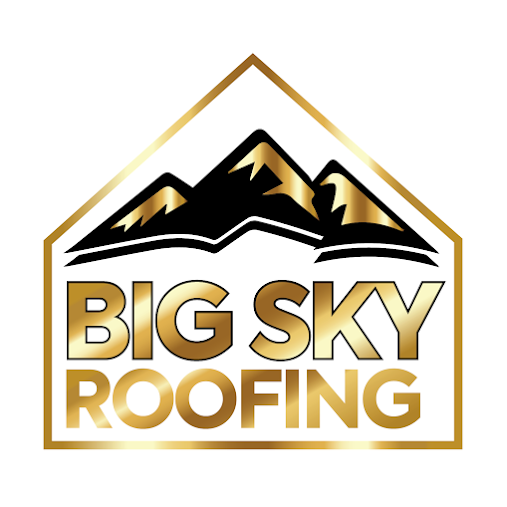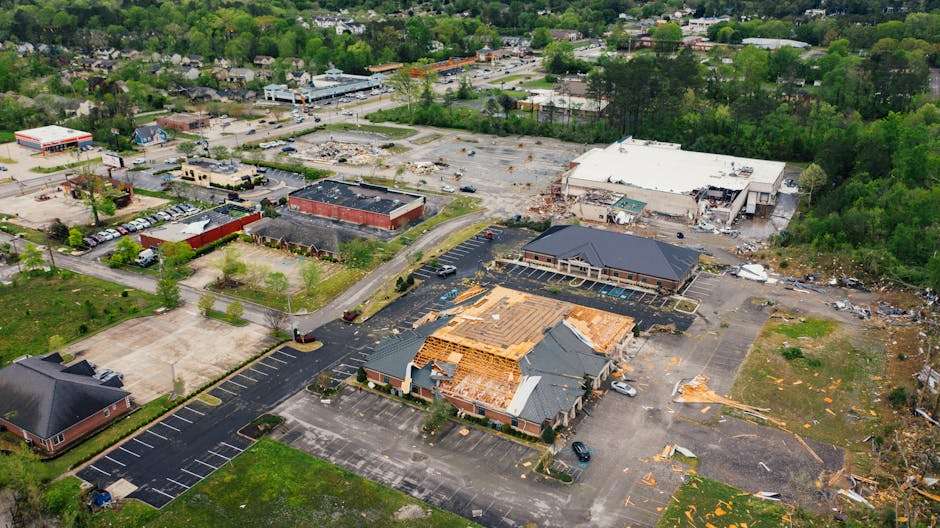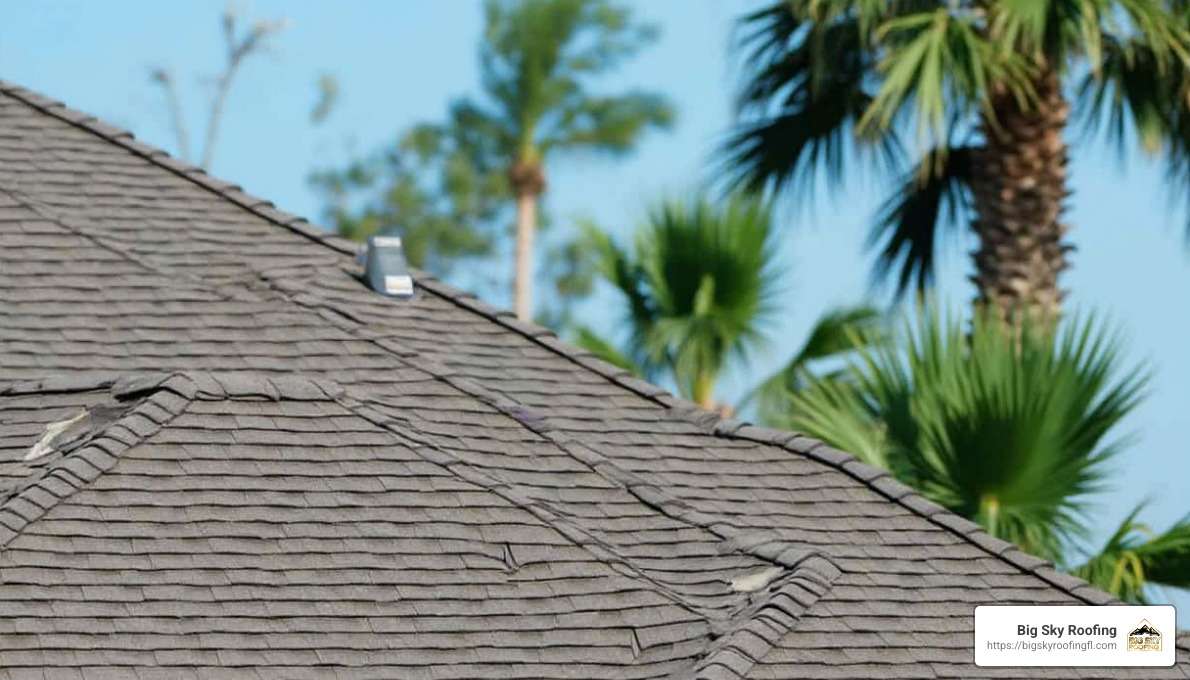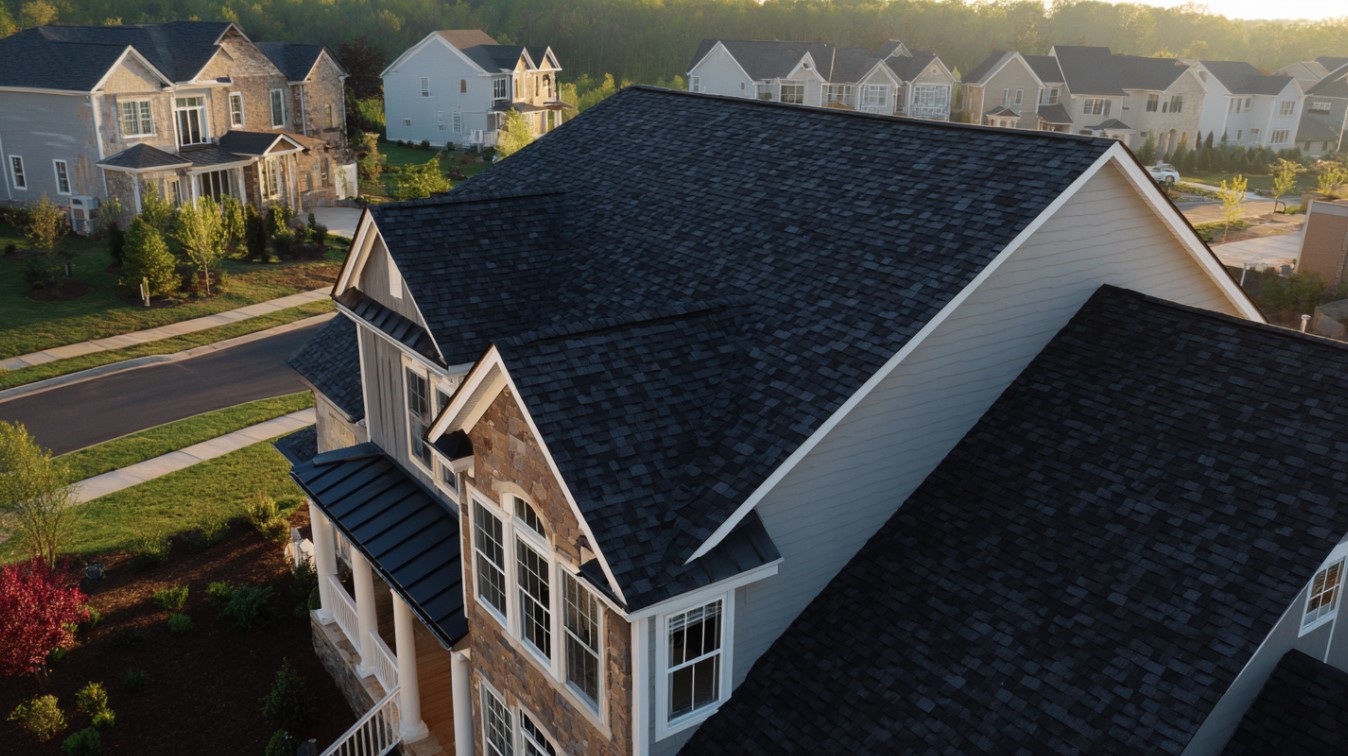Raise the Roof with Residential Shingle Roofing – A Homeowner’s Handbook
•
Written By

Your Complete Guide to Residential Shingle Roofing
Residential shingle roofing is the most popular roofing option for American homeowners, offering an excellent balance of durability, aesthetics, and affordability. If you’re researching roofing options, here’s what you need to know:
Quick Guide to Residential Shingle Roofing:
– Lifespan: 15-50 years depending on material and quality
– Cost: $3.50-$9.00 per square foot installed (varies by region and material)
– Main Types: 3-tab, architectural (dimensional), and designer shingles
– Materials: Asphalt, fiberglass, metal, clay, wood, composite, and solar
– Benefits: Affordable, versatile design options, relatively easy installation
As a Florida homeowner, your roof faces unique challenges from intense UV exposure, heavy rainfall, and the threat of hurricanes. Choosing the right shingle type isn’t just about curb appeal—it’s about protecting your most valuable investment.
“Choosing the right type of roof shingle is an important decision for any homeowner – it literally impacts the roof over your head,” as one roofing expert puts it. This couldn’t be more true for residents in Sumter, Lake, Citrus, Hernando, Orange, and Marion counties, where weather conditions can put roofing materials to the test year-round.
Modern shingle roofing has come a long way from basic asphalt tabs. Today’s options include architectural shingles that are up to 50% heavier than traditional 3-tab varieties, providing improved protection while maintaining structural integrity. Some premium shingles even feature smog-reducing granules that help clean the air—equivalent to planting approximately 2 trees per roof!
Whether you’re building a new home, replacing an aging roof, or repairing storm damage, understanding your shingle options will help you make an informed decision that balances budget, aesthetics, and long-term performance.
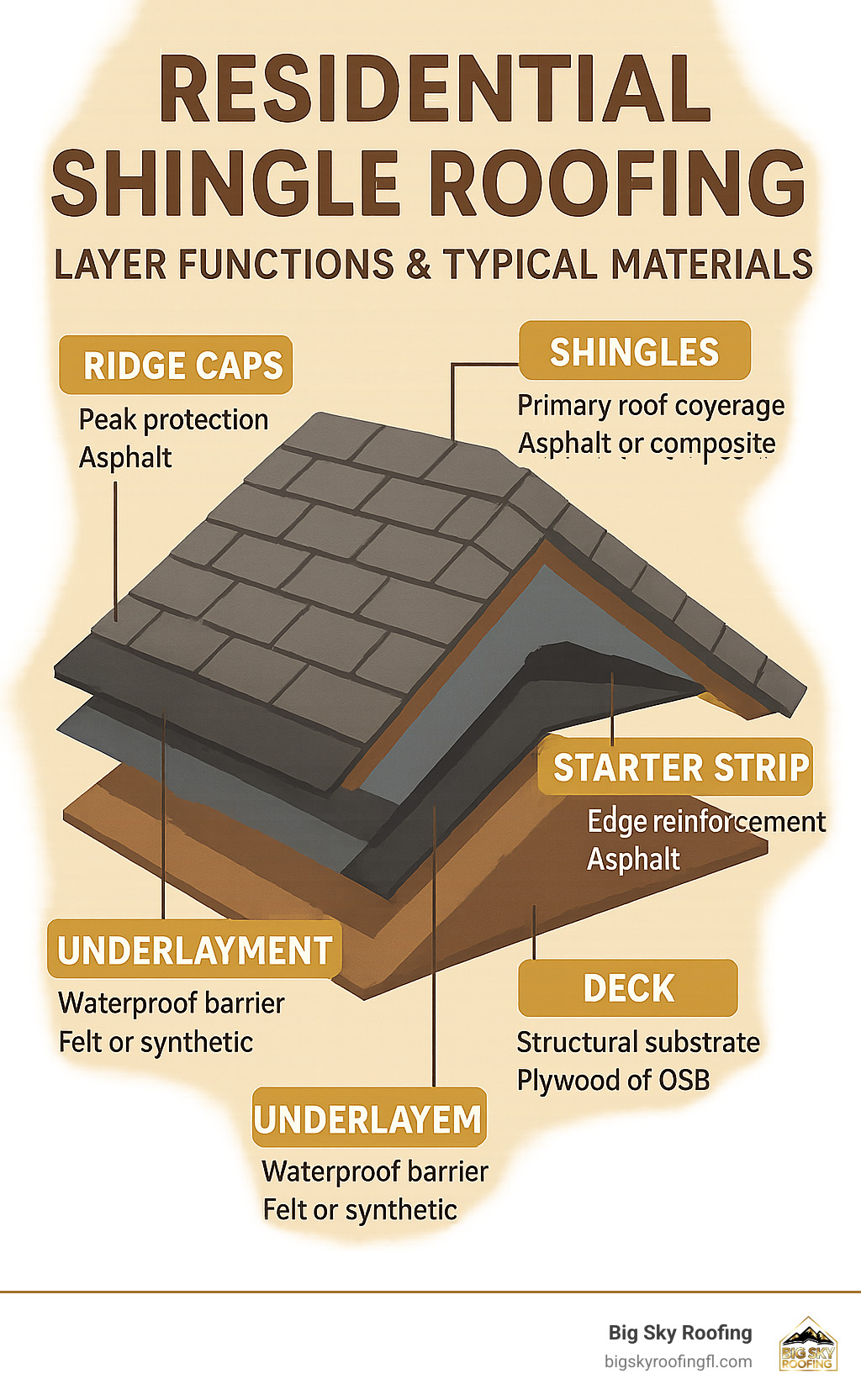

Key residential shingle roofing vocabulary:
– Asphalt shingles Florida
– Roof inspection checklist Florida
– residential roofing services
Residential Shingle Roofing 101: Types, Styles & Performance
When you’re standing in your yard looking up at your roof, you might not realize just how many options exist in residential shingle roofing. After installing thousands of roofs across Central Florida, we at Big Sky Roofing have seen which materials truly stand up to our unique climate challenges.
Main Shingle Materials Every Homeowner Should Know
The humble asphalt shingle remains America’s sweetheart when it comes to roofing. Made with either a fiberglass or organic mat base coated with asphalt and mineral granules, these affordable workhorses offer remarkable versatility in color and style. As industry experts often note, “Asphalt shingles are the most frequently used roofing material for homes in the United States” – and for good reason. They strike that sweet spot between performance and value that homeowners love.
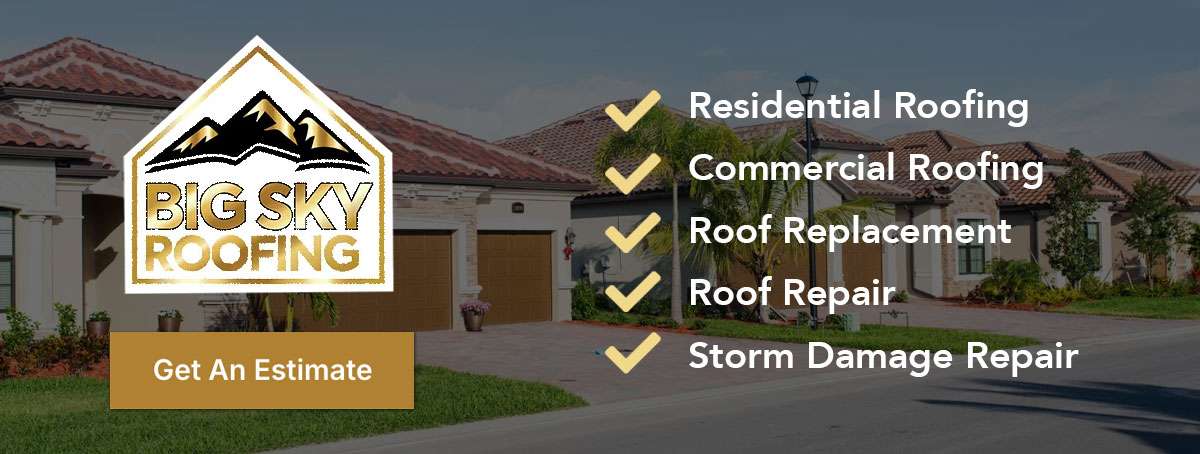
Fiberglass shingles deserve special mention as the more flexible, stronger cousin in the asphalt family. If you’re concerned about fire resistance and waterproofing (and who isn’t in Florida?), these offer excellent protection on both fronts.
Looking for something with extra staying power? Metal shingles might be your answer. Unlike continuous metal panels, these individual pieces cleverly mimic traditional shingles, slate, or even wood shakes. They’re remarkably lightweight yet can last up to 60 years – nearly double what standard asphalt offers. For homeowners in hurricane-prone areas of Sumter, Lake, and Orange counties, their wind resistance is particularly appealing.
Clay tile shingles bring that distinctive Mediterranean or Spanish flair to Florida homes. Available in Spanish (S-shaped), flat (mission), barrel (Roman), interlocking, and glazed varieties, they offer exceptional durability. Just be aware – their beauty comes with weight, requiring stronger roof framing to support them properly.
Wood shingles and shakes offer timeless natural beauty. Cedar shakes gracefully weather to a distinguished silver-gray that many homeowners find irresistible. While they typically outlive asphalt by about a decade, they do demand more TLC, especially in our humid Marion and Citrus County climates.
Composite shingles represent modern innovation at its finest. These synthetic alternatives convincingly mimic slate or wood while offering improved durability and reduced weight. A practical bonus? They can be installed in any season with standard tools.
For the luxury-minded homeowner, natural slate shingles represent the pinnacle of roofing. With proper care, they can protect your home for 50-100+ years. Their substantial weight requires specialized installation and reinforced structures, but many find the investment worthwhile.
The newest kids on the block, solar shingles, generate electricity while functioning as regular roofing. They integrate seamlessly with asphalt shingles for a cohesive look, though at a higher price point that reflects their dual-purpose technology.
3-Tab vs Architectural vs Designer: Which Residential Shingle Roofing Style Fits You?
If you’re leaning toward asphalt (like most Florida homeowners), you’ll need to choose between three main styles:
3-Tab Shingles (Good) offer a flat, uniform appearance that’s been a staple of American homes for decades. They’re the lightweights of the shingle world – both in terms of physical weight and impact on your wallet. With a typical lifespan of 15-20 years and wind resistance up to 60-70 mph, they’re the entry-level option that’s served many Hernando County homeowners well.
Architectural/Dimensional Shingles (Better) step things up with multi-layered construction that creates a textured, three-dimensional look. As one manufacturer’s report highlights, “Architectural shingles are about 50% heavier than 3-tab shingles, providing improved protection from roof leaks and weather elements while maintaining structural integrity.” With mid-range pricing, a 20-30 year lifespan (and warranties often extending to 50 years), plus wind resistance of 110-130 mph, they’ve become the go-to choice for many Lake and Sumter County homeowners.
Designer/Luxury Shingles (Best) represent the premium tier, with appearances that convincingly mimic slate or cedar. They’re the heaviest and thickest option, with corresponding longevity of 25-40+ years and impressive wind resistance up to 130 mph when properly installed. For Orange County homeowners looking to make a statement, these deliver undeniable curb appeal.
Pros, Cons & Typical Lifespans
Each roofing material brings its own strengths and limitations to your home. 3-Tab Asphalt Shingles win on economy and lightweight versatility but offer the shortest lifespan at 15-20 years. Their dimensional appearance is limited, and they provide lower wind resistance – a consideration for hurricane-prone areas.
Architectural Asphalt Shingles deliver exceptional value with improved curb appeal and better wind/impact resistance. Their 20-30 year lifespan justifies the higher cost compared to 3-tab options, though their additional weight might require structural assessment for older Citrus County homes.
Metal Shingles shine with exceptional longevity (40-70 years), high fire resistance, energy efficiency, and recyclability. Yes, they require higher initial investment, and yes, they can be noisy during our famous Florida downpours (though proper installation minimizes this considerably).
Clay/Concrete Tiles offer extreme durability, lasting 50-100 years with excellent thermal properties and distinctive aesthetics that complement many Marion County homes. However, they’re very heavy (requiring structural engineering), come with higher material and installation costs, and can be challenging to replace individually.
Wood Shingles/Shakes bring natural beauty and character with good insulation properties and a 25-40 year lifespan when properly maintained. The downside? Higher maintenance requirements, potential fire hazard (unless treated), and susceptibility to insects and rot in our humid Sumter and Lake County climates.
Want more detailed pricing information? Check out our comprehensive guide on Shingle Prices.
Color & Style Selection Tips
Choosing the right color for your residential shingle roofing goes beyond personal preference – it affects energy efficiency, home value, and neighborhood harmony.


Your home’s architecture offers natural guidance: Colonial homes often look stately with black, dark brown, or gray shingles, while ranch-style homes shine with earth tones like beige or light brown. Mediterranean or Spanish-style homes (popular in parts of Orange and Marion counties) traditionally feature terracotta or clay colors, while modern homes can successfully pull off bold colors or high-contrast options.
Florida’s climate demands special consideration. Lighter colors reflect more heat – an important factor for homes in Sumter, Lake, Citrus, Hernando, Orange, and Marion counties where summer temperatures regularly soar. Darker colors absorb heat, potentially increasing cooling costs. Fortunately, some premium shingles now feature cooling technology regardless of color.
“Check with your HOA before making final decisions,” advises one roofing expert. Many Florida communities have specific guidelines about acceptable roof colors and materials – something we’ve seen cause headaches for homeowners who didn’t do their homework.
When making your final selection, view actual samples in natural light at different times of day, look at installed examples in your neighborhood, consider your home’s existing color scheme, and use manufacturer visualization tools to “try on” different options. Colors often appear darker when installed across an entire roof.
As one Lake County customer told us: “I was surprised how different the shingles looked on my actual roof compared to the small sample. I’m so glad I drove by a few homes with the same color installed before making my final decision.” This practical wisdom has saved many homeowners from color regret!
Eco Friendliness, Lifespan, Cost & Warranty Guide
Today’s residential shingle roofing options have come a long way from the basic materials of yesteryear. Manufacturers now focus on creating products that not only look great but also stand up to Florida’s challenging weather while being kinder to our environment.
Understanding Impact, Wind & Fire Ratings
When shopping for shingles in hurricane-prone Central Florida, these ratings aren’t just technical jargon—they’re your roof’s resume for handling whatever Mother Nature throws its way.
Impact resistance is measured on a scale from Class 1 to Class 4, with Class 4 being the gold standard. These tough shingles can withstand a 2-inch steel ball dropped from 20 feet without cracking! For Florida homeowners who’ve seen their share of severe storms, this protection offers invaluable peace of mind.
Wind ratings are especially crucial for those of us in Sumter, Lake, and other Central Florida counties. The difference between Class D (90 mph) and Class H (150 mph) shingles could determine whether your roof stays put during hurricane season. Many insurance companies recognize this too, offering discounts for homes with higher-rated roofing.
“After Hurricane Irma, we saw how homes with Class H wind-rated shingles fared so much better than those with standard materials,” shares one of our Big Sky project managers who’s been helping Florida homeowners for over 15 years.
Fire ratings also matter, with Class A offering the highest protection. Most fiberglass-based asphalt shingles achieve this top rating, helping protect your home and potentially lowering your insurance premiums in Marion, Orange, and neighboring counties.
Sustainable & Eco-Smart Shingle Options
Going green doesn’t mean sacrificing quality or breaking the bank. Today’s eco-friendly shingles offer impressive environmental benefits while standing up to Florida’s intense sun and frequent storms.
Some of our favorite sustainable options include shingles made with recycled content—imagine keeping the equivalent of 5 tires and 3,200 plastic bags out of landfills with just one roof installation! That’s something to feel good about while protecting your home.
For families concerned about air quality, innovative shingles with smog-reducing granules actually help clean the air around your home. It’s like planting two trees on your roof! This technology is particularly valuable in more densely populated areas of Orange and Hernando counties.
With Florida’s legendary heat, cool roof technology is another game-changer. These special reflective granules can significantly lower your roof’s temperature, potentially saving you hundreds on cooling costs over the summer months. When temperatures regularly hit the 90s across Citrus, Lake and Sumter counties, those savings add up quickly.
Even at the end of your roof’s life, sustainability continues. Reclaimed Asphalt Shingle programs are becoming more common, allowing your old shingles to find new life in road-paving materials rather than sitting in landfills.
For more scientific information about asphalt shingles, check out this Scientific research on asphalt shingles, or visit our detailed guide on Roof Replacement Florida options.
Budget Breakdown & Cost Factors
Understanding what drives roofing costs helps you plan better and avoid surprises. While material costs form the foundation of your budget (ranging from $1.00-$2.00 per square foot for basic 3-tab asphalt to $4.00-$10.00 for premium clay tiles), several other factors influence the final price.
Your roof’s complexity makes a big difference—all those beautiful dormers and skylights that add character to your home also add labor time. The steeper your roof’s pitch, the more challenging (and therefore costly) the installation becomes.
Many homeowners in Marion and Lake counties don’t realize that timing matters too. Summer is peak season for Florida roofers, which can affect pricing. Planning your non-emergency roof replacement for fall or winter might save you money while getting faster service.
The “roofing square” (100 square feet) is how professionals measure your project. An average home in Hernando or Citrus County might need 20-30 squares of roofing material. When getting quotes, make sure you understand whether prices are per square or for the entire project.
Don’t let budget concerns force you into choosing inferior materials. Many of our Central Florida customers are pleasantly surprised to learn about financing options that make quality roofing affordable, from manufacturer financing programs to FHA Title I home improvement loans.
Warranty Demystified
Roof warranties can be as complex as the fine print on your cell phone contract, but understanding them is crucial to protecting your investment.
Most manufacturer warranties offer “limited lifetime” coverage, which typically means full protection for the first 10-15 years, then prorated coverage afterward. But here’s where it gets tricky—many homeowners don’t realize these warranties only cover the materials themselves, not the labor to replace them.
“The difference between a basic warranty and a comprehensive one became crystal clear to one of our Sumter County customers when a manufacturing defect was finded,” explains our warranty specialist. “With the improved warranty we’d recommended, both materials and labor were covered, saving them over $4,000.”
Pay special attention to transferability if you might sell your home. Most warranties allow one transfer to a new owner, which can be a selling point for your property in Orange or Marion County’s competitive real estate markets.
The warranty fine print matters too—many require registration within a specific timeframe (often 30-90 days after installation) and regular documented maintenance. At Big Sky Roofing, we help our customers steer these requirements to ensure their coverage remains intact.
Trends & Innovations Shaping Residential Shingle Roofing
The future of residential shingle roofing is arriving on Florida rooftops today, with exciting innovations that blend technology with traditional protection.
Solar-integrated shingles are becoming more mainstream, allowing Citrus and Lake County homeowners to generate electricity without sacrificing curb appeal. Unlike bulky panels, these look like conventional shingles while helping power your home.
Polymer-modified asphalt represents a significant leap forward in durability. These advanced formulations offer up to 35% greater tear strength and 65% better granule adhesion than standard shingles—crucial qualities when facing Florida’s intense UV exposure and heavy rains.
Smart roofing technology is perhaps the most exciting frontier. Imagine shingles with embedded sensors that can alert you to a leak before water damage occurs, or self-healing materials that can seal minor cracks automatically. These innovations are moving from science fiction to reality in Hernando and Orange counties.
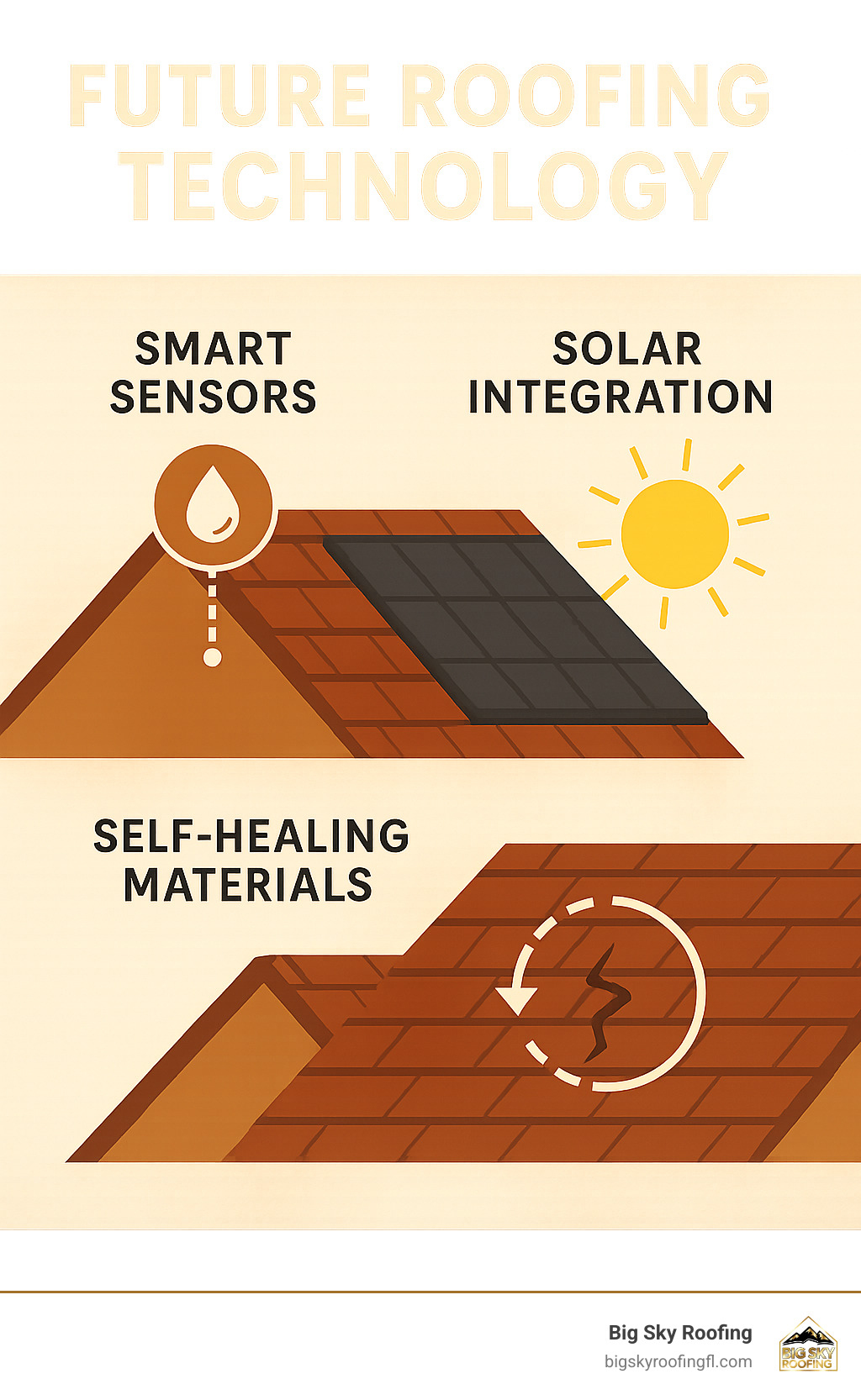

For Florida homeowners who’ve weathered their share of tropical storms, the improvement in weather resistance is particularly valuable. Today’s premium shingles feature up to 50% more adhesive bonds and double the rain seals compared to products from just a decade ago, providing superior protection against wind-driven rain and delamination.
These innovations aren’t just cool technology—they represent real improvements in how your home weathers Florida’s challenging climate, potentially saving you thousands in repair costs over your roof’s lifetime.
From Installation to Maintenance: A Step-by-Step Roadmap
When it comes to residential shingle roofing, choosing quality materials is only half the battle. Proper installation and ongoing maintenance are equally crucial for ensuring your roof’s longevity and performance.
Typical Installation Process Explained
Wonder what happens when professionals install your new shingle roof? Here’s the journey your home will experience:
The process begins with thorough preparation, where our crews protect your landscaping, siding, and windows before carefully removing your existing roofing materials. This “tear-off” phase reveals your roof deck, allowing our experts to inspect for any damage or rot that might be lurking beneath your old shingles.
Next comes the crucial deck preparation stage. We install drip edge along your roof’s perimeter to direct water away from fascia boards, followed by ice and water shield in valleys and around penetrations—especially important for handling Florida’s famous afternoon downpours. A quality synthetic or felt underlayment then creates a secondary moisture barrier across the entire roof surface.
“The foundation work during installation makes all the difference in how your roof performs during our intense Florida storms,” explains one of our project managers. “We never cut corners during this critical phase.”
The shingle installation itself follows a precise sequence. We begin with starter strips along eaves and rakes, then install shingles in overlapping courses using the manufacturer-specified nailing pattern. For homes in our windy Central Florida counties, this typically means 6 nails per shingle rather than the standard 4. Custom flashing around chimneys, vents, and skylights ensures these vulnerable areas remain watertight.
The finishing touches include proper ridge and hip treatments. We install ridge vents to promote proper attic ventilation (crucial for reducing energy costs in our hot climate) and cap everything with specially designed ridge and hip shingles for a clean, finished appearance.
Most residential shingle roofing installations take 1-3 days for completion, depending on your home’s size and roof complexity. We finish with a thorough magnetic sweep for nails, complete debris removal, and a final inspection by your dedicated project manager.
For more information about roof replacement services in your area, visit our Roof Replacement Near Me page.
Selecting a Reputable Contractor in Central Florida
Finding the right roofing partner in Sumter, Lake, Citrus, Hernando, Orange, or Marion counties requires knowing what separates the professionals from the pretenders.
Start by verifying the basics: a valid Florida roofing contractor license, proper insurance coverage (both liability and workers’ comp), and manufacturer certifications from trusted names like GAF, CertainTeed, or Owens Corning. A local physical address and established business history provide additional peace of mind.
Be wary of certain red flags that often signal trouble ahead. Unusually low bids typically indicate corners being cut somewhere—either with subpar materials or inexperienced labor. High-pressure sales tactics, demands for full payment upfront, or vague contract terms should all set off alarm bells.
“We had a neighbor who went with the lowest bid and ended up paying twice—once for the original job and again to fix all the problems,” shared one Lake County homeowner. “We learned from their mistake and chose a certified contractor from the start.”
Before signing any contract, ask potential contractors these essential questions: Can you provide references from recent local jobs? What manufacturer certifications do you hold? Will my project have a dedicated supervisor? How do you handle unexpected issues like deck damage? What warranties do you offer on both materials and workmanship?
At Big Sky Roofing, we’re proud to be among the top 3% of roofing contractors nationally, with elite certifications that allow us to offer extended manufacturer warranties across all the Central Florida counties we serve.
For information about our repair services for existing roofs, visit our Roof Repairs page.
Signs Your Roof Needs Repair or Replacement
Your roof gives warning signs when it’s struggling, and knowing how to read these signals can save you from extensive water damage and costly repairs.
From the outside, watch for missing, cracked, or curling shingles—all indicators that your residential shingle roofing is losing its protective capabilities. Bald spots where granules have worn away leave your roof vulnerable to UV damage, while sagging areas may point to structural concerns beneath. In Florida’s humid climate, moss or algae growth isn’t just an aesthetic issue; these organisms can actually degrade your shingles over time. Damaged flashing around vents and chimneys often creates entry points for water, while visible daylight through roof boards signals serious problems.
Inside your home, water stains on ceilings or walls are obvious red flags, especially if they appear or worsen during rainstorms. Peeling paint or wallpaper may indicate moisture problems, while unexplained increases in energy bills could suggest compromised roof insulation. A trip to your attic might reveal damp insulation—a telltale sign that your roof’s protective barrier is failing.
“When shingle fibers shrink and nail heads become exposed, allowing water to seep in, it’s time to replace your roof,” explains one of our senior inspectors. “For Florida homeowners, postponing necessary roof work before hurricane season is particularly risky. Even minor damage can quickly escalate during a severe storm.”
If you’re experiencing leaks, don’t wait—visit our Roof Leak Repair page for immediate assistance.
Maintenance Checklist to Maximize Roof Life
A well-maintained roof can last years longer than a neglected one. For Florida homeowners, seasonal maintenance should account for our unique climate challenges.
In spring, clear accumulated debris from your roof surface and gutters while checking for shingles damaged during winter storms. Inspect your attic for signs of leaks or improper ventilation, and trim any overhanging branches that could damage shingles during summer thunderstorms.
Summer brings special challenges for residential shingle roofing in Florida. Check for signs of algae or moss growth, which thrive in our humid conditions. Ensure your attic ventilation is working properly to prevent heat buildup that can literally cook your shingles from below. Examine caulking around flashing for cracks caused by thermal expansion.
Fall maintenance should include cleaning gutters of fallen leaves and checking downspouts for proper drainage. After hurricane season, inspect your roof carefully for wind damage, even if your area didn’t experience a direct hit. Before winter, seal any potential animal entry points to prevent nesting.
Even in our mild Florida winters, regular checks for water stains after heavy rains and monitoring for sagging areas can help catch problems early. Make sure your attic insulation remains dry and effective to maximize energy efficiency.
“Regular maintenance isn’t just about extending your roof’s life—it’s about protecting everything beneath it,” notes one of our maintenance specialists. “For Florida homes, installing zinc or copper strips at the ridge can be a smart preventative measure against algae and moss growth.”
For a comprehensive guide to keeping your roof in top condition, visit our Roof Inspection Checklist Florida page.
Frequently Asked Questions about Residential Shingle Roofing
How long does a residential shingle roof last in Florida?
Florida’s sunshine might be great for your tan, but it’s pretty tough on your residential shingle roofing. The truth is, our Central Florida climate creates unique challenges for roofing materials.
Most homeowners can expect their asphalt shingles to last:
– 3-tab shingles: 15-18 years
– Architectural shingles: 20-25 years
– Premium designer shingles: 25-30+ years
Why the shorter lifespan compared to northern states? It’s all about our weather. That beautiful Florida sunshine delivers intense UV radiation that gradually breaks down asphalt. Our famous humidity creates the perfect environment for algae and mold to thrive. Then there’s our rainy season, which puts your roof’s water resistance to the test month after month.
And let’s not forget hurricane season. Even if a major storm doesn’t hit your neighborhood directly, those strong wind gusts gradually test your shingles’ adhesion and can cause premature wear.
“I tell my Lake County customers to think of their roof like they think of their car—regular maintenance extends its life,” says one of our veteran installers. “A quality architectural shingle with proper ventilation can easily reach its full lifespan, even in our challenging climate.”
What affects the overall cost of residential shingle roofing?
When budgeting for your new residential shingle roofing, there’s more to consider than just the basic price per square foot. Several factors can influence your final investment.
Roof design matters. A simple gable roof with few penetrations will cost less than a complex roof with multiple dormers, skylights, and chimneys. Steep pitches require extra safety equipment and take longer to install, increasing labor costs. If your home sits on a difficult lot with limited access, expect the price to reflect the additional challenge.
What’s underneath counts too. Sometimes what we find after removing old shingles affects the budget. Rotted decking needs replacement. Outdated ventilation systems should be upgraded. High-quality synthetic underlayment costs more than traditional felt but provides superior protection—especially important in rainy Sumter and Citrus counties.
Removal and disposal aren’t free. Tearing off existing layers adds labor costs, and disposal fees vary significantly between Marion, Hernando, and Orange counties due to different landfill regulations.
Permits and timing play a role. Each Florida county has different permit fees, and prices often surge during peak season (summer) or after major storms when demand outpaces supply.
For perspective, a typical 2,000 square foot home in Central Florida might cost between $8,000 and $16,000 for a complete asphalt shingle roof replacement, depending on these variables. At Big Sky Roofing, we provide detailed, transparent estimates that account for all these factors upfront—no surprises.
Can I install or repair shingles myself?
While those DIY videos make residential shingle roofing look straightforward, there’s a reason roofing consistently ranks among the most dangerous professions.
Safety should be your first concern. Falls remain the leading cause of construction fatalities nationwide. Now add Florida’s summer heat, which can push roof surface temperatures well above 150°F, creating dangerous working conditions even for experienced professionals. Working on steep slopes requires specialized safety equipment that most homeowners don’t have and aren’t trained to use properly.
Your warranty protection is at stake. Most manufacturers’ warranties explicitly require professional installation. One homeowner in Hernando County learned this lesson the hard way when his insurance denied a claim because his DIY installation didn’t meet Florida’s strict building codes for hurricane zones.
The technical aspects are more complex than they appear. Proper nailing patterns directly affect your roof’s wind resistance—critical in our hurricane-prone region. Underlayment installation requires precise overlapping to prevent leaks during Florida’s heavy downpours. As one of our project managers puts it: “A properly installed roof has about 2,000 nails, and each one needs to be in exactly the right spot. That’s before we even talk about proper flashing installation.”
The tool requirements are substantial. Professional-grade roofing nailers, safety harnesses, specialized cutting tools—the investment in equipment alone often exceeds what you’d save on labor.
For minor repairs like replacing a few damaged shingles after a storm, some handy homeowners can manage the task safely. But for most roof issues, professional inspection and repair provide peace of mind and long-term protection for your home.


Conclusion
As the Florida sun sets over a freshly installed roof, there’s something deeply satisfying about knowing your home is well-protected for years to come. Residential shingle roofing isn’t just a practical necessity—it’s an investment in your family’s comfort, safety, and peace of mind.
Throughout this guide, we’ve walked through the many options available to Florida homeowners, from economical 3-tab shingles to premium architectural designs that can withstand our unique climate challenges. The right choice for your home balances durability against our intense UV exposure, resistance to our frequent heavy rains, and the fortitude to stand up to hurricane-force winds that occasionally test our communities.

For our neighbors in Sumter, Lake, Citrus, Hernando, Orange, and Marion counties, we understand that a roof is more than just building materials—it’s protection for your most valuable investment. That’s why at Big Sky Roofing, we’ve dedicated over 25 years to helping Central Florida homeowners steer these important decisions with confidence.
Your roof works as a complete system, with each component playing a vital role in your home’s protection. From the underlayment that provides a secondary moisture barrier to the proper ventilation that extends shingle life, every detail matters. That’s why professional installation isn’t just a recommendation—it’s essential for maximizing performance and longevity.
Whether storm damage has forced an unexpected replacement, your aging roof is showing signs of wear, or you’re building your dream home from the ground up, you don’t have to make these decisions alone. Our team of certified professionals understands local building codes, weather patterns, and neighborhood aesthetics that matter to Florida homeowners.
We’ve helped thousands of families across Central Florida sleep better during stormy nights, knowing their homes are protected by quality materials installed with care and precision. We’d be honored to do the same for you.
Ready to protect your home with a beautiful, durable roof system? We invite you to reach out for a free, no-obligation estimate on your residential shingle roofing project. Let’s work together to find the perfect roofing solution for your home, budget, and peace of mind.
For more information about our comprehensive residential roofing services, visit our Residential Roofing page.
